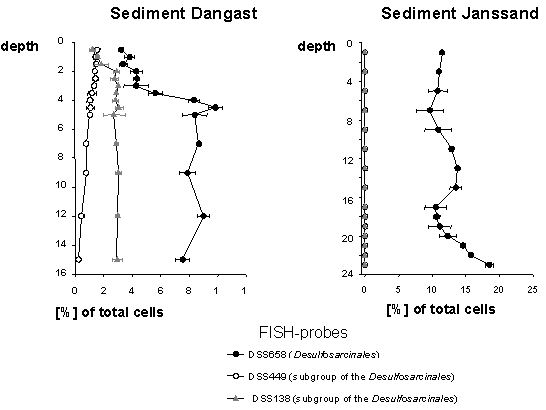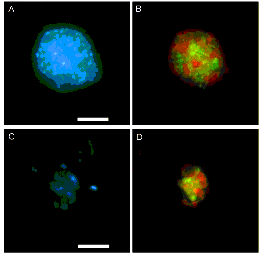
BioGeoChemistry of Tidal Flats
Microbial community structure of intertidal surface sediments
Goal of this project was to characterize the microbial community mainly of anaerobically respiring bacteria in surface sediments of the Wadden Sea.
In this environment the dissimilatory reduction of sulfate besides aerobic respiration plays a central role in carbon mineralization. At the first study site, a muddy and estuarine sediment in Dangast, we studied the diversity and distribution of cultured and uncultured sulfate-reducing bacteria (SRB) by molecular biological tools. Two groups of SRB were shown to be numerically abundant. Up ot 10% of all bacteria were related to Desulfosarcinales, whereas 2% belonged to Desulfobulbaceae of the δ-Proteobacteria. From the latter we have isolated four strains that represented an abundant subgroup with unusual metabolic properties among SRB. Two subpopulations of the Desulfosarcinales were identified in the most upper layers at the Dangast site. These bacteria are likely globally distributed and might be abundant elsewhere. However, habitat specific features may superimpose their geographical distribution. At a reference site, a sandy sediment (Janssand), these two specific subpopulations were not found despite a high abundance of Desulfosarcinales.

Up to 6% of all bacteria affiliated with Fe(III)-Mn(IV)-S° reducing bacteria of the Desulfuromonas-Pelobacter-group. The comparable abundances of this group and SRB points at a so far underestimated contribution of metal/sulfur-reducers to carbon mineralization.
Surprisingly we also detected consortia of ANME-2 Archaea and Desulfosarcinales in the Janssand sediment. These morphologically resembled consortia responsible for anaerobic methane oxidation in gas hydrates off the coast of Oregon. Maybe these organisms thrive in a anoxic, sulfate depleted and potentially methan emitting niches in upper surface layers. Further results point at substantial differences in community compostion between these niches and the bulk sediment.
The basis for all these results was the optimization of the fluorescence in situ hybridization (FISH) for marine sediments. The sensitivity of this method was largely increased by application and adaption of a signal amplifying reporter system (CARD-FISH) previously developed by Perntahler et al. (2001).

Epifluorescence photomicrographs of CARD-FISH-stained microorganisms. DAPI (blue), and probe ARCH915 and EelMS932 ( both Archaea, green) and Desulfosarcinales (red) Scale bar, 5 µm.
|
Relevant publications:
- Llobet-Brossa E, Rabus R, Böttcher ME, Könneke M, Finke N, Schramm A, Meyer RL, Grötzschel St, Rosselló-Mora R, Amann R (2002) Community structure and activity of sulfate-reducing bacteria in an intertidal surface sediment: a multi-method approach. Aquat Microb Ecol 29: 211-226
- Mussmann M, Ishii K, Rabus R, Amann R (2004) Diversity and vertical distribution of cultured and uncultured deltaroteobacteria in an intertidal mudflat of the Wadden Sea. Environ. Microbiol, 7 (3): 405-418
- Ishii K, Mussmann M, McGregor B, Amann R (2004) An improved fluorescence in situ hybridization protocol for the identification of bacteria and archaea in marine sediments. FEMS Microbiol. Ecol, 50: 203-212
| <<back | All publications
|